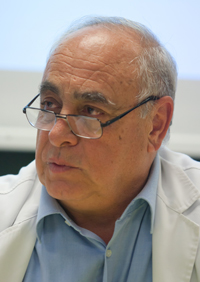Héctor Luis Mancini Maza, Professor Emeritus of Physics, University of Navarra, Spain
Of gravitational waves and macroexperiments

Among the scientists who made important discoveries but also predictions, Albert Einstein, who is credited with anticipating the existence of gravitational waves, stands out. Although science is a collective creation, whose great advances are usually produced in a previous environment or "cultural state", the case of Einstein is an example B because in his lifetime he produced both very important anticipations -such as the theory of Relativity- and explanations, for example of the photoelectric effect, for which he was awarded the award Nobel Prize in Physics.
Gravitational waves are a logical consequence contained in the equations of Relativity that Einstein presented in a lecture at the Prussian State Library Services in November 1915. At the beginning of the 20th century, the wave phenomena of both electromagnetic waves, produced by the accelerated motion of charges, and probability waves were investigated in the wave quantum mechanics of the subject. It was to be expected that the existence of gravity waves would also be explored, within the equations of Relativity for the case of accelerated particles.
In the latter case, Einstein himself doubted the possibility of verification, because it is a very weak phenomenon and because of the enormous masses required and the great distance at which they are located. The difficulty, therefore, was in the verification. Until advertisement, by researchers at project LIGO (Laser Interferometry Gravitational-waves Observatory), the first direct observation of this subject of waves. It took a hundred years to master the techniques that would make the experiment possible and for the theoretical ideas and numerical simulation methods to mature.
According to Relativity, these waves should be produced in places where enormous masses can be accelerated. For example, in the merger of black holes or galaxies, pairs of neutron stars, supernovae, etc. The accelerated masses would emit radiation in the form of waves that would propagate in space-time at the speed of light in a vacuum.
With them we can determine the position of the source, the distance, etc., providing an alternative source of information to the known astronomical observations. Therefore, its confirmation adds a new tool to the observation of the cosmos. Moreover, it is the largest and most precise optical observation instrument, based on laser interferometry. To get an idea of its precision, it is capable of detecting a path difference of the order of one ten-thousandth of the diameter of an atomic nucleus.
This project, which was initiated by Caltech and MIT in the USA (1983), now involves more than 1,000 researchers from 15 countries. Together they have given rise to LIGO, an instrument consisting of two identical detectors deployed 3,000 km from each other. The signal they have detected comes from a merger that occurred 1.3 billion years ago. A violent meeting of two black holes whose mass is greater than 30 times that of the Sun. The two holes collapsed into one, releasing energy equivalent to three solar masses, which was released in the form of gravitational waves in a fraction of a second.
However, LIGO is not the only experiment dedicated to this observational task. There are European initiatives, such as the project VIRGO or the LISA Pathfinder, a project to place these observations in space. In any case, this validation has served to remind us that Einstein, in addition to waves, also predicted the existence of Stimulated Emission, the phenomenon on which lasers are based.
But why does a news item, of undoubted interest to specialists, achieve such a high social impact? Large scientific projects, involving groups of researchers from several countries, have great funding needs, which they try to support by taking great care in the public dissemination of their results, beyond science. Likewise, human beings need absolute, credible and verifiable references, beyond the level of hypotheses, so we look to the so-called exact sciences as a platform to support us in the face of the relativity of human certainties.
